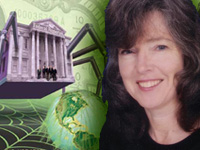Ellen Brown - The Web of Debt & The Manufactured Financial Crash

"The great Oz as spoken! Pay no attention to that man behind the curtain! I am the great and powerful Wizard of Oz!"
In refreshing contrast to the impenetrable writings of economists, the classic fairytale The Wizard of Oz has delighted young and old for over a century. It was first published by L. Frank Baum as The Wonderful Wizard of Oz in 1900. In 1939, it was made into a hit Hollywood movie starring Judy Garland, and later it was made into the popular stage play The Wiz. Few of the millions who have enjoyed this charming tale have suspected that its imagery was drawn from that most obscure and tedious of subjects, banking and finance. Fewer still have suspected that the real-life folk heroes who inspired its plot may have had the answer to the financial crisis facing the country today!
The economic allusions in Baum's tale were first observed in 1964 by a schoolteacher named Henry Littlefield, who called the story "a parable on Populism," referring to the People's Party movement challenging the banking monopoly in the late nineteenth century.1 Other analysts later picked up the theme. Economist Hugh Rockoff, writing in the Journal of Political Economy in 1990, called the story a "monetary allegory."2 Professor Tim Ziaukas, writing in 1998, stated:
"The Wizard of Oz" . . . was written at a time when American society was consumed by the debate over the "financial question," that is, the creation and circulation of money. . . . The characters of "The Wizard of Oz" represented those deeply involved in the debate: the Scarecrow as the farmers, the Tin Woodman as the industrial workers, the Lion as silver advocate William Jennings Bryan and Dorothy as the archetypal American girl.3
The Germans established the national fairytale tradition with Grimm's Fairy Tales, a collection of popular folklore gathered by the Brothers Grimm specifically to reflect German populist traditions and national values.4 Baum's tale did the same thing for the American populist (or people's) tradition. The Wizard of Oz has been called "the first truly American fairytale."5 It was all about people power, manifesting your dreams, finding what you wanted in your own backyard. According to Littlefield, the march of Dorothy and her friends to the Emerald City to petition the Wizard of Oz for help was patterned after the 1894 march from Ohio to Washington of an "Industrial Army" led by Jacob Coxey, urging Congress to return to the Greenback system initiated by Abraham Lincoln. The march of Coxey's Army on Washington began a long tradition of people taking to the streets in peaceful protest when there seemed no other way to voice their appeals. ⇒
interview part 1
interview part 2


0 Comments:
Post a Comment
<< Home